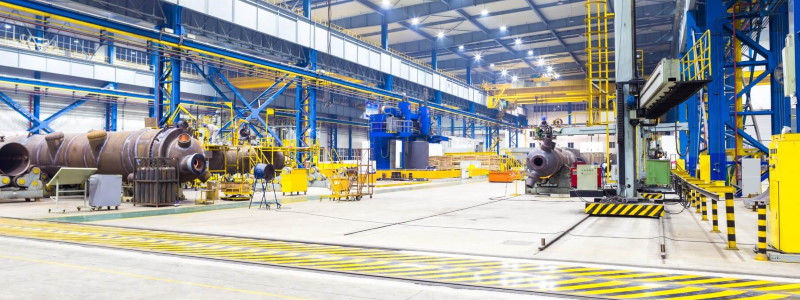LED Lighting is the Smart Choice for Industrial Facilities
With the rising concern over energy costs, LED lighting has become the go-to illumination source for reducing a company's electric bill. Many designers, however, believe that the cost of LED lighting is still too high to justify them for large-scale industrial lighting projects. The reality is that LED technology has advanced so fast that even when upfront cost is taken into account, LED lighting is the best choice for even the largest manufacturing plants being built today. In this article, we’ll review why LED light fixtures are the ideal choice for industrial and manufacturing facilities.
Fixture Cost (or Lumens per Dollar)
The types of light fixtures used to illuminate most large industrial facilities are the same that have seen the largest improvement in price and performance. We’re talking about LED high bays, panels or troffers, down lights, as well as wall packs and site lighting fixtures. These fixture categories have seen a vast number of factories enter the space since the first products were introduced. With increased competition has come massive price drops while the quality of the product has improved as well. Until recently, the standard for efficiently lighting large industrial spaces was either the T5HO fluorescent high bay or pulse-start metal halide high bays. These fixtures were large and required expensive materials like specular reflectors or glass refractors. They were also at the end of their development life cycle so few companies were investing in the improvement of these products. The improvements in LED technology have allowed manufacturers to make smaller fixtures that can produce the same light output as fluorescent or metal halide high bays produce. This has lowered the cost of manufacturing and shipping for LED high bays significantly. The best metric to measure these fixtures by is delivered lumens per dollar. While traditional fluorescent high bays could reach 130 lumens per dollar, we’re now starting to see LED high bays reach 150 lumens per dollar or higher.Energy Cost Savings (or Lumens per Watt)
Every discussion of LED lighting usually starts out by pointing out the energy cost savings advantage of LEDs. This is the biggest reason to consider LED lights for a new facility. LED fixtures are by far the more energy efficient fixture, saving 40%-60% in electricity costs over traditional lighting sources. A typical 6-lamp T5HO high bay consumes 342W and produces roughly 21,000 usable lumens after taking into account fixture efficacy and lumen depreciation. This equates to only 63 lumens per Watt. Today’s LED high bay fixtures can easily generate 130 lumens per Watt or more! We can now replace a 6 lamp T5HO high bay and get the same amount of light output with a 165W LED high bay.Maintenance Cost Savings
Manufacturing facilities are known for having complex floor plans with machinery and equipment that cannot be easily moved. This leads to lighting systems that are difficult to reach and expensive to maintain. Many factories have to shut down production in order to perform work in overhead lighting systems. While some facilities can schedule this type of work, it leads to delaying relamping or replacing fixtures which can impact the lighting in critical areas. The lifespan of an LED fixture is significantly higher than either fluorescent or metal halide lamps. LED light fixtures can easily have a rated life over 50,000 hours and some can even reach over 100,000 hours. With a longer life, facilities can schedule fewer relamp/reballast projects and maintain proper light levels for a longer period of time. This translates to lower system maintenance costs that go right to the bottom line.Ruggedness and Longevity
Even though many of these fixtures are high up in a facility lighting industrial processes, that does not mean that they can’t be damaged. Traditional high bays with glass lamps or fluorescent tubes were subject to damage when hit by a forklift as material was being relocated in storage areas. LED light fixtures are inherently more rugged. The solid-state diodes that generate the light don’t have any moving parts and are very difficult to damage. This means fewer replacements which also reduces maintenance costs.More Controllable
Fluorescent fixtures brought in a plethora of benefits when compared to metal halide fixtures in terms of their ability to turn on quickly. This allowed designers to start adding occupancy sensors to building areas that were used less often in order to reduce consumption. When the sensors recognized activity in the area, they would turn the fixtures on. If the space went vacant, the sensor would turn the future off. On-Off control is great, but the addition of full dimming capability adds much more flexibility. Now areas can harvest daylight or adjust brightness based on ambient conditions. The vast majority of LED fixtures are dimmable, which was not easy to do with fluorescent fixtures. Dimming allows the building owner to control the fixtures and provide just the right light levels for the activities being performed.Good for the Environment
The higher energy efficiency of LEDs translates to a reduced carbon footprint for your company. For today’s environmentally-aware consumer, that means a better profile for your business. LED luminaires are also mercury free unlike their metal halide and fluorescent counterparts. Fixtures and lamps will not be difficult to recycle when they come to the end of their life cycle.How Can We Help?
With all of the advantages we’ve mentioned above, choosing an LED Lighting system for your industrial facility should be a no brainer. At RelightDepot, we can help you select just the right fixtures for each space in your facility. With decades of experience, we have the know-how and the low prices to make your projects a success. Contact us to discuss your project and get started today.
April 21, 2020







